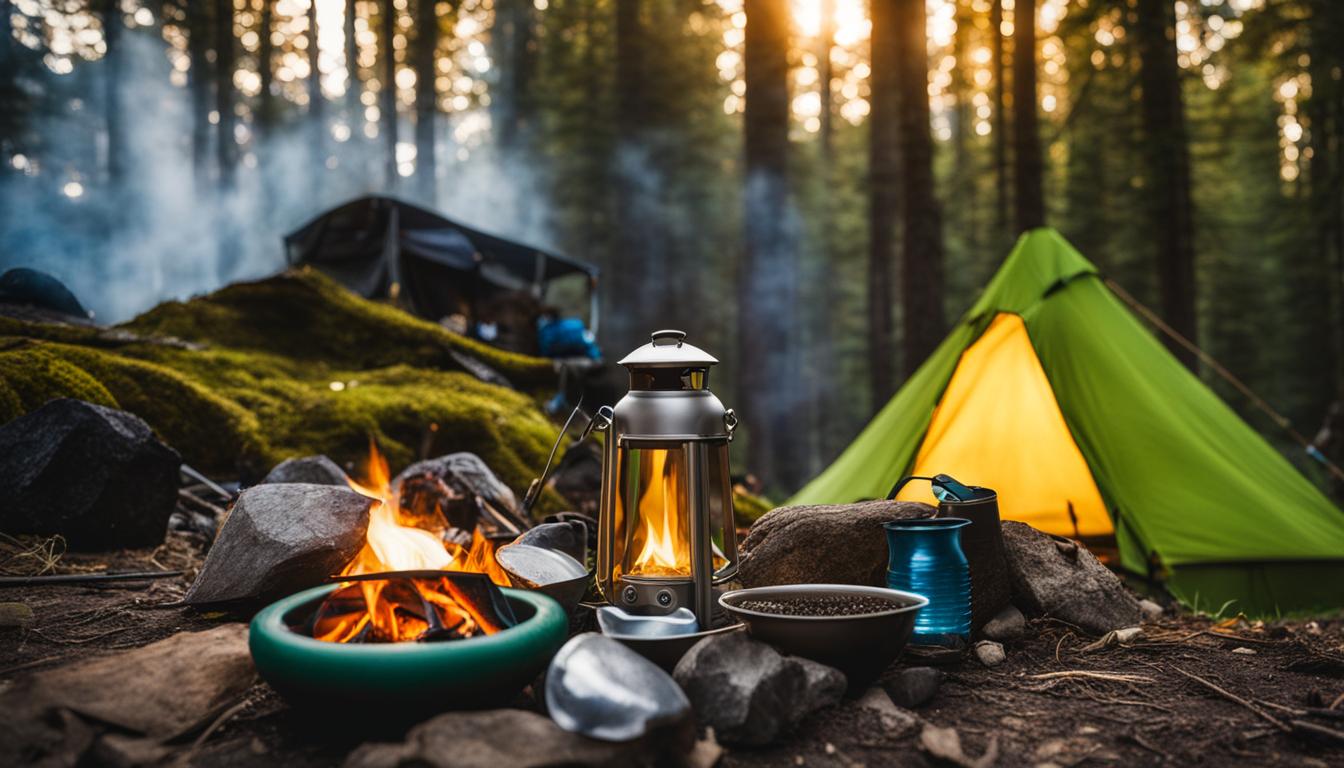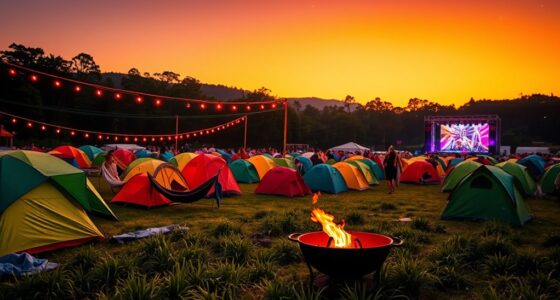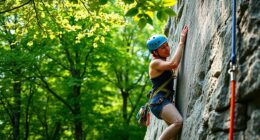Are you someone who loves nature and wants to spend time outdoors while being mindful of the environment? You’ve come to the right place! This guide will delve into the realm of eco-friendly camping and offer advice on how to make your camping trip sustainable and environmentally friendly. Whether it’s selecting a suitable camping spot or using eco-friendly camping equipment, we have everything you need to know.
Eco-camping or sustainable camping is all about enjoying nature while taking steps to reduce waste and protect the environment. By opting for reusable containers, sustainable products, and minimizing waste, we can ensure that our camping trips have a minimal impact on the beautiful natural surroundings. So let’s dive in and discover the wonders of eco-friendly camping!
Key Takeaways:
- Choose eco-friendly camping gear to minimize your environmental impact.
- Make sustainable food choices by shopping locally and using reusable containers.
- Follow Leave No Trace principles to preserve the beauty of nature.
- Proper waste management is crucial for eco-friendly camping.
- Respect wildlife and their habitats for a more sustainable camping experience.
The Benefits of Eco-Camping
Eco-camping offers several benefits, both environmental and otherwise. By practicing sustainability while camping, we can reduce our impact on the environment, save money, and reduce greenhouse gas emissions. Additionally, eco-camping contributes to our physical and mental wellbeing, encourages environmental conservation, and allows us to connect with nature in a meaningful way.
Environmental Benefits
- Minimizes environmental impact: By following eco-friendly camping tips and using sustainable practices, we can minimize our carbon footprint and preserve natural ecosystems.
- Reduces waste: Using reusable containers, choosing sustainable camping gear, and properly managing waste helps to minimize the amount of trash that ends up in landfills and natural environments.
- Preserves natural resources: By opting for sustainable practices, such as conserving water and using renewable energy sources, we can help protect the Earth’s precious resources.
Personal Benefits
- Physical and mental wellbeing: Camping in natural surroundings, free from the distractions of modern life, allows us to recharge, reduce stress, and improve our overall health.
- Connection with nature: Eco-camping provides opportunities to immerse ourselves in the beauty of nature, fostering a deeper appreciation for the environment and our place within it.
- Educational and inspirational: Experiencing the wonders of the natural world firsthand can inspire us to become more environmentally conscious and make sustainable choices in our daily lives.
Eco-camping not only benefits the environment but also enhances our own well-being. By adopting eco-friendly camping practices, we can enjoy the wonders of nature while actively contributing to its preservation for future generations to enjoy.
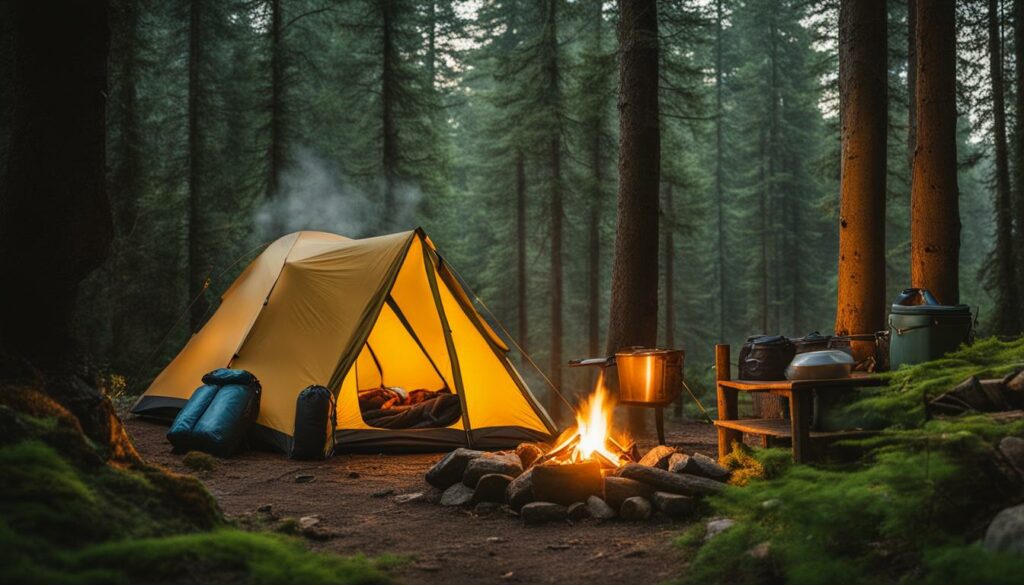
| Benefits | Environmental | Personal |
|---|---|---|
| Minimizes environmental impact | ✓ | |
| Reduces waste | ✓ | |
| Preserves natural resources | ✓ | |
| Physical and mental wellbeing | ✓ | |
| Connection with nature | ✓ | |
| Educational and inspirational | ✓ |
Choosing the Right Camping Location
When planning an eco-friendly camping trip, it’s important to choose a camping location that is environmentally friendly. By selecting the right destination, we can minimize our impact on the environment and ensure a more sustainable camping experience. Here are some tips for choosing the right camping location:
- Consider alternative destinations: Instead of choosing popular and overcrowded camping spots, explore lesser-known destinations that are off the beaten path. This will not only allow you to enjoy a more peaceful camping experience but also reduce the strain on the environment.
- Choose off-peak seasons: Camping during off-peak seasons can help minimize the impact on the environment. By avoiding peak times, you can help reduce overcrowding and preserve the natural beauty of the camping area.
- Be mindful of local wildlife: Before choosing a camping location, research the local wildlife and their habitats. Avoid camping in areas where it may disturb mating or nesting seasons. Respecting the natural cycles of wildlife is essential for their survival.
By taking these factors into consideration, we can ensure that our camping trips have a minimal impact on the environment and contribute to the preservation of natural ecosystems. Choosing the right camping location is the first step towards an eco-friendly camping experience.
“Choosing the right camping location is crucial for an eco-friendly camping experience. By selecting alternative destinations, avoiding peak seasons, and being mindful of local wildlife, we can minimize our impact on the environment and ensure a more sustainable camping trip.”
| Camping Location | Environmentally Friendly Features | Activities |
|---|---|---|
| Greenwood State Park | – Emphasis on conservation and sustainability – Recycling and waste management facilities – Renewable energy sources |
– Hiking trails – Bird watching – Canoeing |
| Mount Rainier National Park | – Strict regulations to protect the ecosystem – Education programs on Leave No Trace principles – Wildlife conservation initiatives |
– Camping in designated areas – Climbing – Wildlife spotting |
| Big Sur, California | – Preservation of the natural landscape – Limited development and commercialization – Protection of endangered species |
– Coastal hikes – Beach camping – Whale watching |
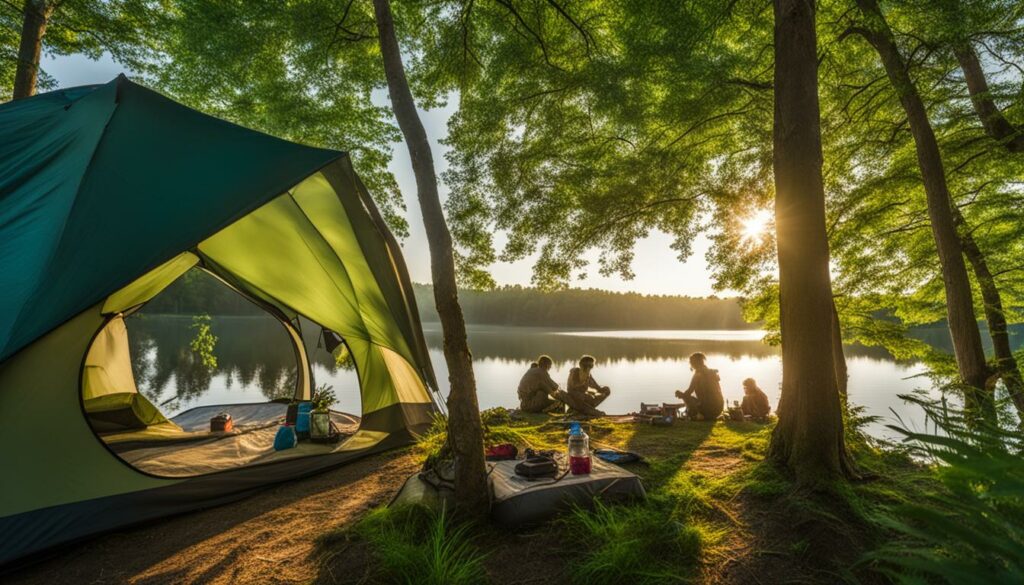
Here are some eco-friendly camping destinations that are known for their commitment to sustainability:
- Greenwood State Park: Located in the heart of a lush forest, Greenwood State Park offers an eco-friendly camping experience. With an emphasis on conservation and sustainability, this park provides recycling and waste management facilities, as well as renewable energy sources. Outdoor enthusiasts can enjoy hiking trails, bird watching, and canoeing while appreciating the park’s commitment to environmental preservation.
- Mount Rainier National Park: Nestled in the Cascade Mountains, Mount Rainier National Park is a haven for nature lovers. The park has strict regulations to protect the ecosystem and offers education programs on Leave No Trace principles. With wildlife conservation initiatives in place, campers can enjoy camping in designated areas, climbing towering peaks, and spotting wildlife while minimizing their impact on the environment.
- Big Sur, California: Known for its breathtaking coastline and rugged beauty, Big Sur is a popular destination for eco-conscious campers. The area prioritizes the preservation of the natural landscape, with limited development and commercialization. Big Sur is also dedicated to protecting endangered species. Camping in this stunning location allows visitors to experience coastal hikes, beach camping, and the awe-inspiring sight of migrating whales.
By choosing these eco-friendly camping destinations, we can immerse ourselves in nature while supporting the efforts to preserve and protect our planet.
Using Sustainable Camping Gear
When it comes to eco-friendly camping, using sustainable camping gear is essential. By opting for gear that is designed with environmental sustainability in mind, we can minimize our impact on the environment and contribute to a more sustainable camping experience. Here are some tips for using eco-friendly camping gear:
- Choose gear made from recycled or sustainable materials: Look for camping gear made from recycled materials such as recycled plastic or upcycled fabrics. Additionally, opt for gear made from sustainable materials like bamboo or hemp, which have a lower environmental impact compared to traditional materials.
- Invest in high-quality, durable gear: Instead of purchasing cheap gear that may need to be replaced frequently, invest in high-quality gear that will last for multiple camping trips. By choosing gear that is built to last, we can reduce our need for replacements and minimize waste.
- Borrow or buy secondhand gear: Before purchasing new gear, consider borrowing or buying secondhand equipment. This not only reduces the demand for new products but also gives pre-loved gear a new lease on life, reducing waste and extending the lifespan of camping gear.
- Properly maintain and repair gear: Extend the life of your camping gear by properly maintaining and repairing it. Regularly clean and store gear properly to prevent damage and keep it in good working condition. In the event of minor damage, consider repairing gear instead of immediately replacing it.
By following these sustainable camping practices and choosing eco-friendly camping gear, we can minimize our environmental impact and contribute to a more sustainable and enjoyable camping experience.

Packing Sustainable Food Options
When it comes to eco-friendly camping, choosing sustainable food options is essential. Not only does it contribute to minimizing our environmental impact, but it also ensures we prioritize our own health. Here are some tips for packing sustainable food options for your next camping adventure:
- Shop locally: Support local farmers and reduce the carbon footprint of your food by shopping at farmers’ markets or grocery stores that source their products locally. Look for organic and sustainably grown options whenever possible.
- Minimize packaging waste: Instead of relying on pre-packaged meals and snacks, bring your own reusable containers. Opt for bulk foods and make your own meals from pantry ingredients. This not only reduces packaging waste but also allows for more control over the quality and nutritional value of your meals.
- Choose sustainable proteins: Consider alternative protein sources such as plant-based options or sustainably caught fish. These choices have a lower environmental impact compared to conventional meat products.
- Use a water filter: Instead of relying on single-use plastic water bottles, invest in a portable water filter. This allows you to drink water from natural sources like streams or lakes, reducing the need for disposable plastic bottles.
By packing sustainable food options, we can enjoy delicious meals while minimizing our impact on the environment. Remember, every small choice we make contributes to a more sustainable camping experience and a healthier planet.
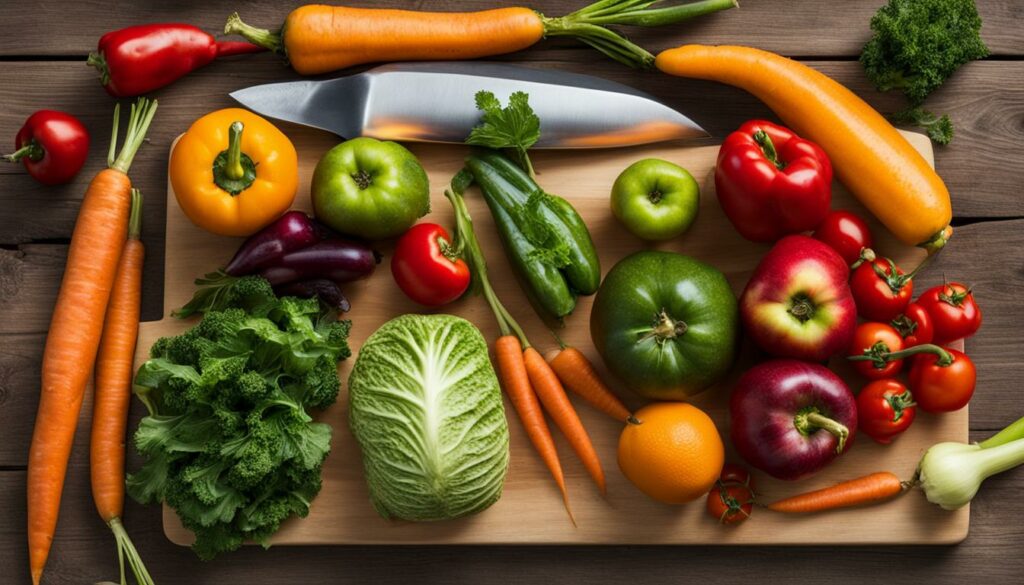
Table: Sustainable Food Options for Camping
| Food Category | Sustainable Options |
|---|---|
| Proteins | Plant-based protein sources like lentils, beans, and tofu Sustainably caught fish |
| Fruits and Vegetables | Locally grown and organic produce Fruits and vegetables that can withstand outdoor conditions |
| Grains and Staple Foods | Whole grains like quinoa and brown rice Unprocessed foods like oats and whole wheat bread |
| Snacks | Nuts and seeds Homemade granola or energy bars Dried fruits with no added sugars or preservatives |
| Beverages | Reusable water bottles Herbal teas and coffee with biodegradable filters |
Practicing Leave No Trace Principles

When it comes to eco-friendly camping, one of the most important principles to follow is Leave No Trace. This means ensuring that our presence in nature leaves no discernable signs behind. By practicing Leave No Trace principles, we can minimize our impact on the environment and preserve the beauty of nature for future generations.
Leave No Trace Principles
There are seven core principles of Leave No Trace that we should follow while camping:
- Plan ahead and prepare: By properly planning our camping trip, we can ensure we have all the necessary equipment and knowledge to minimize our impact.
- Travel and camp on durable surfaces: It’s important to stick to established trails and camp on durable surfaces like rock, gravel, or snow, to avoid damaging sensitive vegetation.
- Dispose of waste properly: We should always pack out our trash and dispose of it in designated receptacles. For human waste, we should dig catholes at least 6 to 8 inches deep and 200 feet away from water sources.
- Leave what you find: To preserve the natural environment, we should refrain from picking flowers, collecting rocks, or disturbing wildlife. Leave everything as you found it.
- Minimize campfire impacts: If campfires are allowed, we should use established fire rings or fire pans and only burn small, dead wood. Once done, we should completely extinguish the fire and scatter the ashes.
- Respect wildlife: Observing wildlife from a safe distance is important for their wellbeing. We should never feed or approach wildlife, as this can disrupt their natural behavior.
- Be considerate of other visitors: Being respectful and considerate of fellow campers enhances the camping experience for everyone. We should keep noise levels down and respect other campers’ privacy.
By following these principles, we can ensure that our camping experience is not only enjoyable but also environmentally friendly. Let’s keep our natural spaces pristine and beautiful for generations to come.
Eco-Friendly Camping: Proper Waste Management
The Importance of Proper Waste Management
Waste management is a crucial aspect of eco-friendly camping. By effectively managing waste, we can minimize our environmental impact and contribute to a cleaner and more sustainable camping experience. Proper waste management not only helps protect the natural beauty of our surroundings but also ensures the well-being of wildlife and prevents pollution of our water sources.
Practices for Eco-Friendly Waste Management
When camping, it’s important to bring reusable trash bags and separate recyclables from non-recyclable waste. This allows us to dispose of waste responsibly and minimize the amount of trash that ends up in landfills. If recycling or composting facilities are not available at the campsite, it is recommended to take all waste back home for proper disposal.
Furthermore, we should strive to minimize our waste production by choosing products with minimal packaging and opting for reusable items. By reducing our reliance on single-use plastics and disposable products, we can significantly decrease the amount of waste generated during our camping trips.
A Complete Guide to Waste Disposal
Here is a table outlining proper waste disposal methods for common camping items:
| Item | Disposal Method |
|---|---|
| Food Scraps | Dispose of them in a designated composting area or take them back home for composting. |
| Plastic Bottles and Containers | Rinse and recycle them if recycling facilities are available. Otherwise, pack them up and take them home for proper recycling. |
| Glass Bottles | Store them in a safe container, away from camping areas, and dispose of them in recycling facilities. |
| Disposable Utensils and Plates | Opt for reusable alternatives whenever possible. If using disposable items, make sure to pack them up and dispose of them properly. |
| Hygiene Products | Always carry biodegradable toiletries and sanitary items. Pack them in a resealable bag and take them home for proper disposal. |
Remember, proper waste management is essential for eco-friendly camping. By following these practices, we can enjoy the great outdoors while minimizing our environmental impact and preserving nature for future generations.

Eco-Friendly Camping Tips and Sustainable Practices
When it comes to eco-friendly camping, there are several tips and practices that can help us minimize our impact on the environment while enjoying the great outdoors. By adopting sustainable camping practices, we can contribute to the preservation of natural ecosystems and promote a more environmentally friendly camping experience. Here are some eco-friendly camping tips to consider:
1. Choose Biodegradable Toiletries
When camping, it’s essential to be mindful of the environmental impact of our personal care products. Opt for biodegradable toiletries, such as biodegradable soap, shampoo, and toothpaste. These products are designed to break down naturally, reducing their impact on ecosystems. Additionally, always carry water at least 200 yards away from any body of water when bathing to prevent contamination. Properly dispose of all waste, including toilet paper, in reusable trash bags.
2. Use Solar-Powered Lights
Reduce your reliance on disposable batteries and opt for solar-powered lights instead. Solar-powered lanterns and flashlights harness the sun’s energy during the day and provide illumination at night. They are a sustainable and cost-effective alternative that helps to reduce waste and minimize your environmental impact.
3. Pack Reusable Utensils and Containers
Avoid single-use plastics by packing reusable utensils and containers for your camping trip. Use durable, eco-friendly options such as stainless steel water bottles, bamboo cutlery, and silicone food storage bags. These alternatives not only reduce waste but also help to conserve resources and promote sustainable practices.
| Benefits of Eco-Friendly Camping Tips and Sustainable Practices |
|---|
| Minimizes environmental impact |
| Preserves natural ecosystems |
| Reduces waste and promotes sustainability |
| Conserves resources and saves money |
| Connects us with nature in a meaningful way |
By incorporating these eco-friendly camping tips and sustainable practices into our camping routine, we can make a positive difference in protecting our environment. Remember, every small action counts, and together, we can enjoy the outdoors responsibly while preserving the natural beauty for future generations.
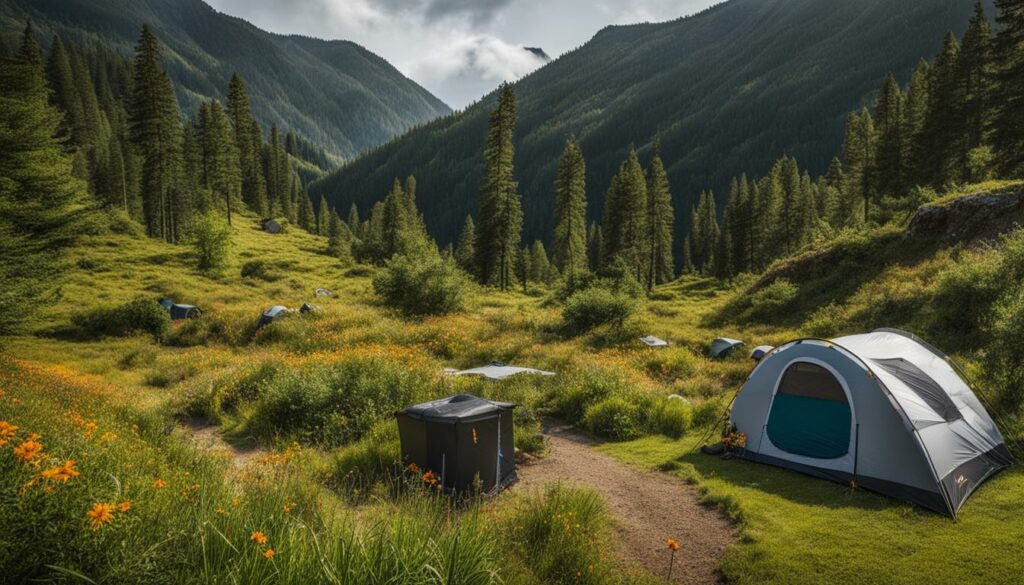
Wildlife Conservation and Respectful Behavior
When engaging in eco-friendly camping, it is essential to prioritize wildlife conservation and exhibit respectful behavior towards the natural environment. By practicing proper etiquette and following guidelines, we can ensure the preservation of delicate ecosystems and promote a sustainable camping experience.
Respecting Wildlife
One of the fundamental principles of eco-friendly camping is to observe wildlife from a safe distance and avoid any actions that may disturb or harm them. It is important to resist the temptation to feed or touch wildlife as it disrupts their natural behavior and can lead to dependency on human contact. By appreciating wildlife from afar, we can protect their habitats and foster their continued well-being.
Controlled Pet Behavior
If we decide to bring our pets along on camping trips, it is crucial to keep them under control at all times. Unleashed animals can disturb wildlife, damage natural habitats, and pose a potential threat to both the environment and other campers. It is advisable to keep pets on leashes and ensure their waste is properly disposed of to maintain a clean and respectful camping environment.
Minimizing Light and Noise Pollution
Light and noise pollution can have significant impacts on the behavior and well-being of wildlife. When camping, we should aim to minimize excessive artificial lighting and avoid playing loud music or making unnecessary noise. By keeping our surroundings as natural and quiet as possible, we can create a peaceful and undisturbed environment for wildlife, allowing them to thrive undisturbed.
Conclusion
By observing wildlife from a safe distance, controlling our pets, minimizing light and noise pollution, and adopting other respectful behaviors, we can contribute to the conservation of wildlife and their habitats while enjoying an eco-friendly camping experience. Our actions as responsible campers can help preserve the delicate balance of nature and promote a sustainable environment for generations to come.
Community Engagement and Education
Community engagement and education play a crucial role in promoting sustainable camping practices and fostering a collective commitment to preserving our environment. By actively engaging with fellow campers and sharing knowledge about eco-friendly camping tips, we can inspire others to adopt more sustainable habits and contribute to a greener future.
One effective way to encourage community engagement is to organize clean-up activities during camping trips. By coming together and dedicating some time to clean up the surrounding area, we can actively contribute to reducing waste and preserving the natural beauty of our campgrounds. These activities also provide an opportunity to educate others about the importance of responsible waste management and the long-lasting impact that our actions can have on the environment.
Table: Impact of Community Engagement
| Benefits of Community Engagement | Examples |
|---|---|
| Increased awareness | Organizing workshops to educate campers about sustainable camping practices |
| Positive behavior change | Encouraging others to switch to reusable camping gear |
| Support for local conservation efforts | Collaborating with organizations to protect fragile ecosystems |
| Strengthened sense of community | Creating online platforms to share experiences and tips |
In addition to hands-on activities, sharing knowledge and resources is essential for building a strong camping community committed to sustainability. Utilize online platforms, social media, and camping forums to share eco-friendly camping tips, sustainable gear recommendations, and local conservation efforts. By fostering a sense of collaboration and support, we can create a network of environmentally conscious campers who inspire and learn from one another.
Lastly, it’s important to advocate for local conservation efforts and support organizations that work towards preserving natural environments. By partnering with and contributing to these initiatives, we can collectively make a significant impact in safeguarding our planet for future generations to enjoy.
Remember, sustainable camping practices are not just our individual responsibility, but a collective effort to minimize our impact on the environment. Through community engagement, education, and active participation, we can create a camping culture that prioritizes sustainability and helps to preserve the beauty of nature for years to come.
Conclusion
Eco-friendly camping, also known as green camping or eco-conscious camping, provides us with an incredible opportunity to connect with nature while taking steps to minimize our impact on the environment. By following eco-friendly camping tips and adopting sustainable practices, we can enjoy the great outdoors while preserving the natural beauty of our planet.
Throughout this guide, we have explored various aspects of eco-friendly camping, from choosing the right camping location to practicing proper waste management. We have learned the importance of using sustainable camping gear, packing sustainable food options, and practicing Leave No Trace principles.
It’s crucial to remember that every small action counts when it comes to green camping. By making conscious choices and embracing sustainable practices, we contribute to the preservation of our natural ecosystems and inspire others to do the same. Together, we can make a positive difference in protecting our environment for future generations to enjoy.
FAQ
What is eco-friendly camping?
Eco-friendly camping, also known as sustainable camping, focuses on minimizing the impact on the environment while enjoying the great outdoors. It involves using eco-friendly camping gear and following practices that reduce waste and protect natural environments.
What are the benefits of eco-camping?
By practicing sustainability while camping, individuals can reduce their impact on the environment, save money, and reduce greenhouse gas emissions. Additionally, eco-camping contributes to physical and mental well-being, encourages environmental conservation, and allows campers to connect with nature in a meaningful way.
How do I choose an eco-friendly camping location?
When planning an eco-friendly camping trip, it’s important to choose a camping location that is environmentally friendly. Consider alternative destinations or off-peak seasons to avoid overcrowded areas and minimize the strain on the environment. Additionally, be mindful of local wildlife and avoid camping in areas where it may disturb mating or nesting seasons.
What gear should I use for eco-friendly camping?
Using sustainable camping gear is essential for eco-friendly camping. Instead of buying brand new equipment, consider borrowing or buying secondhand gear. Look for high-quality items that will last for multiple camping trips and reduce the need for replacements. By choosing eco-friendly camping gear, campers can minimize their environmental impact and contribute to a more sustainable camping experience.
How can I pack sustainable food options for camping?
When it comes to eco-friendly camping, choosing sustainable food options is important. Shop locally to reduce the carbon footprint of your food and minimize packaging waste by making your own meals from pantry ingredients. Bring reusable containers to avoid single-use plastics and consider using a water filter to drink from natural water sources. By packing sustainable food options, campers can prioritize their own health while also reducing their impact on the environment.
What are Leave No Trace principles in eco-friendly camping?
Leave No Trace principles are fundamental to eco-friendly camping. Beyond picking up trash, campers should aim to leave no discernible signs that they were at their campsite. This includes not disturbing the natural environment, observing wildlife from a distance, and properly disposing of waste. By following Leave No Trace principles, campers can minimize their impact on the environment and preserve the beauty of nature for future generations.
How should I manage waste during eco-friendly camping?
Proper waste management is crucial for eco-friendly camping. Campers should bring reusable trash bags and separate recyclables from non-recyclable waste. If recycling or composting facilities are not available at the campsite, campers should take their waste home for proper disposal. By effectively managing waste, campers can reduce their environmental impact and contribute to a cleaner and more sustainable camping experience.
What are sustainable hygiene practices for camping?
Maintaining proper hygiene while camping is important, but it’s also necessary to consider the environmental impact of personal care products. Choose biodegradable toiletries and carry water at least 200 yards away from any body of water when bathing. Properly dispose of all waste, including toilet paper, in reusable trash bags. By practicing sustainable hygiene practices, campers can stay clean and healthy while minimizing their impact on the environment.
How can I contribute to wildlife conservation while camping?
Wildlife conservation is a key aspect of eco-friendly camping. Campers should respect wildlife by observing them from a safe distance and not feeding or disturbing them. It’s important to control pets at all times or leave them at home if possible. By being mindful of wildlife and their habitats, campers can contribute to the preservation of natural ecosystems and promote a sustainable camping experience.
How can I engage with the camping community and promote sustainability?
Sustainable camping is most effective when treated as a community endeavor. Campers can encourage others to practice eco-friendly camping by organizing clean-up activities, sharing knowledge about sustainable practices, and promoting local conservation efforts. By engaging with the camping community and spreading awareness, campers can have a broader positive impact on the environment and inspire others to adopt sustainable camping practices.

